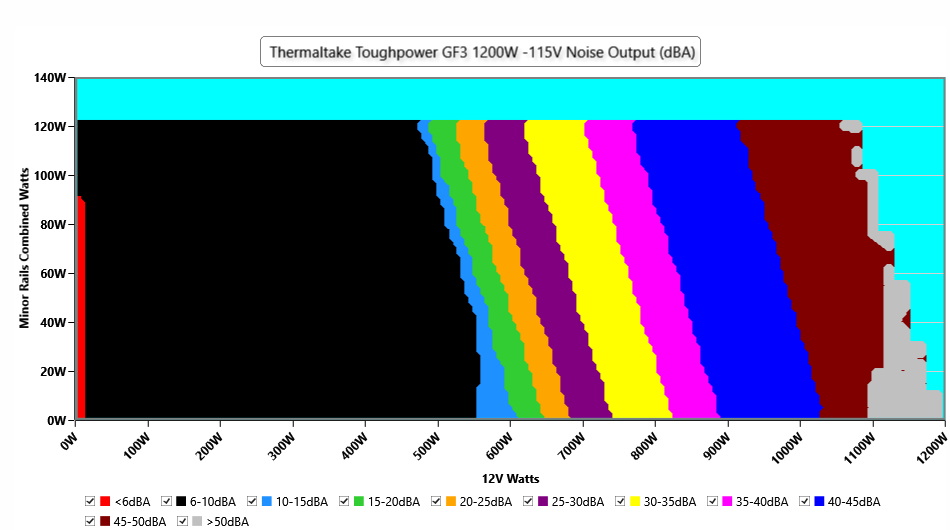Why you can trust Tom's Hardware
To learn more about our PSU tests and methodology, please check out How We Test Power Supply Units.
Primary Rails And 5VSB Load Regulation
The following charts show the main rails' voltage values recorded between a range of 40W up to the PSU's maximum specified load, along with the deviation (in percent). Tight regulation is an important consideration every time we review a power supply because it facilitates constant voltage levels despite varying loads. Tight load regulation also, among other factors, improves the system’s stability, especially under overclocked conditions and, at the same time, it applies less stress to the DC-DC converters that many system components utilize.
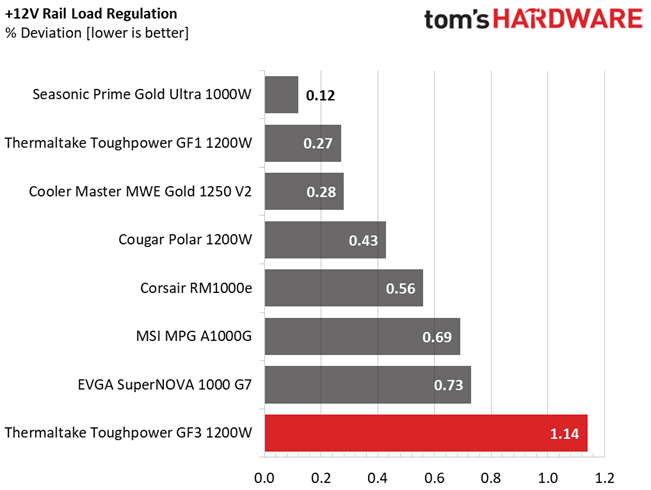



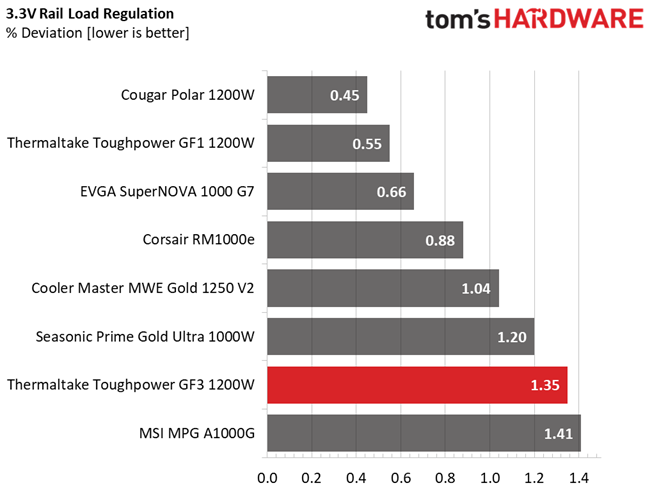


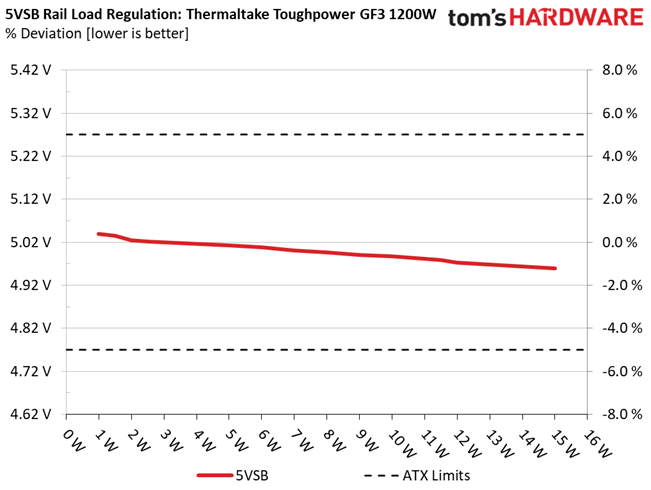
Load regulation is not tight, especially at 12V.
Hold-Up Time
Put simply; hold-up time is the amount of time that the system can continue to run without shutting down or rebooting during a power interruption.




The hold-up time is long and the power ok signal is accurate.
Inrush Current
Inrush current, or switch-on surge, refers to the maximum, instantaneous input current drawn by an electrical device when it is first turned on. A large enough inrush current can cause circuit breakers and fuses to trip. It can also damage switches, relays, and bridge rectifiers. As a result, the lower the inrush current of a PSU right as it is turned on, the better.


Inrush current is low with 115V and pretty high with 230V.
Get Tom's Hardware's best news and in-depth reviews, straight to your inbox.
Leakage Current
In layman's terms, leakage current is the unwanted transfer of energy from one circuit to another. In power supplies, it is the current flowing from the primary side to the ground or the chassis, which in the majority of cases is connected to the ground. For measuring leakage current, we use a GW Instek GPT-9904 electrical safety tester.
The leakage current test is conducted at 110% of the DUT's rated voltage input (so for a 230-240V device, we should conduct the test with 253-264V input). The maximum acceptable limit of a leakage current is 3.5 mA and it is defined by the IEC-60950-1 regulation, ensuring that the current is low.

Leakage current is low.
10-110% Load Tests
These tests reveal the PSU's load regulation and efficiency levels under high ambient temperatures. They also show how the fan speed profile behaves under increased operating temperatures.
| Test | 12V | 5V | 3.3V | 5VSB | DC/AC (Watts) | Efficiency | Fan Speed (RPM) | PSU Noise (dB[A]) | Temps (In/Out) | PF/AC Volts |
| 10% | 8.133A | 1.989A | 2.008A | 0.998A | 120.024 | 86.631% | 0 | <6.0 | 44.34°C | 0.977 |
| Row 2 - Cell 0 | 12.101V | 5.027V | 3.287V | 5.013V | 138.549 | Row 2 - Cell 6 | Row 2 - Cell 7 | Row 2 - Cell 8 | 40.11°C | 114.9V |
| 20% | 17.282A | 2.986A | 3.016A | 1.198A | 239.996 | 90.182% | 0 | <6.0 | 45.51°C | 0.985 |
| Row 4 - Cell 0 | 12.098V | 5.025V | 3.283V | 5.008V | 266.121 | Row 4 - Cell 6 | Row 4 - Cell 7 | Row 4 - Cell 8 | 40.79°C | 114.88V |
| 30% | 26.793A | 3.485A | 3.523A | 1.4A | 359.41 | 91.457% | 418 | 7.8 | 41.45°C | 0.982 |
| Row 6 - Cell 0 | 12.069V | 5.022V | 3.279V | 5.001V | 392.988 | Row 6 - Cell 6 | Row 6 - Cell 7 | Row 6 - Cell 8 | 46.65°C | 114.85V |
| 40% | 36.393A | 3.985A | 4.031A | 1.602A | 479.776 | 91.399% | 472 | 9.0 | 41.95°C | 0.984 |
| Row 8 - Cell 0 | 12.051V | 5.02V | 3.275V | 4.996V | 524.925 | Row 8 - Cell 6 | Row 8 - Cell 7 | Row 8 - Cell 8 | 47.71°C | 114.82V |
| 50% | 45.625A | 4.983A | 5.044A | 1.804A | 599.503 | 90.928% | 713 | 21.4 | 42.54°C | 0.987 |
| Row 10 - Cell 0 | 12.033V | 5.018V | 3.271V | 4.991V | 659.323 | Row 10 - Cell 6 | Row 10 - Cell 7 | Row 10 - Cell 8 | 48.99°C | 114.78V |
| 60% | 54.955A | 5.982A | 6.059A | 2A | 720.003 | 90.217% | 993 | 32.0 | 42.89°C | 0.989 |
| Row 12 - Cell 0 | 12.014V | 5.016V | 3.268V | 4.987V | 798.087 | Row 12 - Cell 6 | Row 12 - Cell 7 | Row 12 - Cell 8 | 49.87°C | 114.76V |
| 70% | 64.253A | 6.982A | 7.078A | 2.209A | 839.767 | 89.342% | 1371 | 41.2 | 43.37°C | 0.991 |
| Row 14 - Cell 0 | 11.994V | 5.014V | 3.264V | 4.982V | 939.941 | Row 14 - Cell 6 | Row 14 - Cell 7 | Row 14 - Cell 8 | 50.69°C | 114.72V |
| 80% | 73.636A | 7.985A | 8.097A | 2.311A | 959.742 | 88.413% | 1761 | 48.0 | 43.7°C | 0.992 |
| Row 16 - Cell 0 | 11.976V | 5.011V | 3.26V | 4.978V | 1085.525 | Row 16 - Cell 6 | Row 16 - Cell 7 | Row 16 - Cell 8 | 51.81°C | 114.68V |
| 90% | 83.302A | 8.487A | 8.598A | 2.414A | 1079.541 | 87.462% | 2146 | 52.7 | 44.69°C | 0.993 |
| Row 18 - Cell 0 | 11.969V | 5.009V | 3.256V | 4.973V | 1234.298 | Row 18 - Cell 6 | Row 18 - Cell 7 | Row 18 - Cell 8 | 53.71°C | 114.66V |
| 100% | 92.765A | 8.991A | 9.132A | 3.025A | 1199.581 | 86.434% | 2176 | 53.2 | 45.3°C | 0.994 |
| Row 20 - Cell 0 | 11.964V | 5.006V | 3.252V | 4.96V | 1387.863 | Row 20 - Cell 6 | Row 20 - Cell 7 | Row 20 - Cell 8 | 55.38°C | 114.62V |
| 110% | 102.179A | 9.997A | 10.259A | 3.027A | 1320.045 | 85.475% | 2176 | 53.2 | 46.67°C | 0.995 |
| Row 22 - Cell 0 | 11.957V | 5.003V | 3.246V | 4.957V | 1544.333 | Row 22 - Cell 6 | Row 22 - Cell 7 | Row 22 - Cell 8 | 57.57°C | 114.6V |
| CL1 | 0.116A | 14.406A | 14.528A | 0A | 121.317 | 81.634% | 511 | 10.4 | 42.92°C | 0.978 |
| Row 24 - Cell 0 | 12.124V | 5.013V | 3.283V | 5.04V | 148.616 | Row 24 - Cell 6 | Row 24 - Cell 7 | Row 24 - Cell 8 | 48.36°C | 114.9V |
| CL2 | 0.115A | 21.958A | 0A | 0A | 111.427 | 79.901% | 510 | 10.4 | 43.94°C | 0.978 |
| Row 26 - Cell 0 | 12.132V | 5.011V | 3.29V | 5.058V | 139.46 | Row 26 - Cell 6 | Row 26 - Cell 7 | Row 26 - Cell 8 | 50.97°C | 114.91V |
| CL3 | 0.118A | 0A | 22.141A | 0A | 74.03 | 76.148% | 441 | 8.2 | 44.6°C | 0.965 |
| Row 28 - Cell 0 | 12.105V | 5.026V | 3.279V | 5.02V | 97.219 | Row 28 - Cell 6 | Row 28 - Cell 7 | Row 28 - Cell 8 | 53.65°C | 114.91V |
| CL4 | 100.249A | 0A | 0A | 0A | 1200.001 | 87.271% | 2179 | 53.3 | 46.39°C | 0.994 |
| Row 30 - Cell 0 | 11.970V | 5.023V | 3.257V | 5.009V | 1375.037 | Row 30 - Cell 6 | Row 30 - Cell 7 | Row 30 - Cell 8 | 56.35°C | 114.64V |
The PSU doesn't have a problem delivering full load, and more, at high operating temperatures, but the fan's noise goes through the roof, exceeding 50 dBA.
20-80W Load Tests
In the following tests, we measure the PSU's efficiency at loads significantly lower than 10% of its maximum capacity (the lowest load the 80 Plus standard measures). This is important for representing when a PC is idle with power-saving features turned on.
| Test | 12V | 5V | 3.3V | 5VSB | DC/AC (Watts) | Efficiency | Fan Speed (RPM) | PSU Noise (dB[A]) | Temps (In/Out) | PF/AC Volts |
| 20W | 1.230A | 0.496A | 0.501A | 0.198A | 20.009 | 78.374% | 0 | <6.0 | 40.11°C | 0.891 |
| Row 2 - Cell 0 | 12.083V | 5.044V | 3.296V | 5.04V | 25.53 | Row 2 - Cell 6 | Row 2 - Cell 7 | Row 2 - Cell 8 | 36.97°C | 114.94V |
| 40W | 2.706A | 0.695A | 0.701A | 0.298A | 40.009 | 82.467% | 0 | <6.0 | 41.85°C | 0.927 |
| Row 4 - Cell 0 | 12.086V | 5.04V | 3.295V | 5.035V | 48.516 | Row 4 - Cell 6 | Row 4 - Cell 7 | Row 4 - Cell 8 | 38.37°C | 114.92V |
| 60W | 4.182A | 0.894A | 0.903A | 0.398A | 60.009 | 86.194% | 0 | <6.0 | 42.57°C | 0.964 |
| Row 6 - Cell 0 | 12.085V | 5.031V | 3.29V | 5.025V | 69.61 | Row 6 - Cell 6 | Row 6 - Cell 7 | Row 6 - Cell 8 | 38.8°C | 114.92V |
| 80W | 5.658A | 1.094A | 1.104A | 0.498A | 79.971 | 86.291% | 0 | <6.0 | 43.97°C | 0.963 |
| Row 8 - Cell 0 | 12.078V | 5.029V | 3.288V | 5.022V | 92.673 | Row 8 - Cell 6 | Row 8 - Cell 7 | Row 8 - Cell 8 | 39.98°C | 114.91V |
Efficiency with light loads is high, and the fan doesn't have to spin, despite the over 40 degrees Celsius ambient temperatures.
2% or 10W Load Test
From July 2020, the ATX spec requires 70% and higher efficiency with 115V input. The applied load is only 10W for PSUs with 500W and lower capacities, while for stronger units, we dial 2% of their max-rated capacity.
| 12V | 5V | 3.3V | 5VSB | DC/AC (Watts) | Efficiency | Fan Speed (RPM) | PSU Noise (dB[A]) | Temps (In/Out) | PF/AC Volts |
| 1.800A | 0.26A | 0.26A | 0.054A | 24.149 | 79.14% | 0 | <6.0 | 30.35°C | 0.912 |
| Row 2 - Cell 0 | 12.058V | 5.042V | 3.295V | 5.041V | 30.508 | Row 2 - Cell 6 | Row 2 - Cell 7 | 27.83°C | 114.92V |
With a 2% load, efficiency is sky-high!
Efficiency & Power Factor
Next, we plotted a chart showing the PSU's efficiency at low loads and loads from 10 to 110% of its maximum rated capacity. The higher a PSU’s efficiency, the less energy goes wasted, leading to a reduced carbon footprint and lower electricity bills. The same goes for Power Factor.





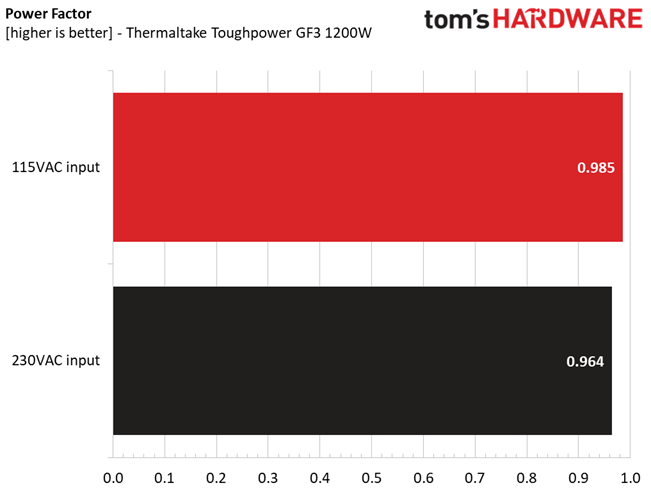
Efficiency is notably higher with 230V compared to 115V input, especially at high loads. Overall, the platform achieves sky-high efficiency with light loads, but there is room for improvement with normal loads.
5VSB Efficiency
| Test # | 5VSB | DC/AC (Watts) | Efficiency | PF/AC Volts |
| 1 | 0.1A | 0.506W | 75.977% | 0.064 |
| Row 2 - Cell 0 | 5.057V | 0.666W | Row 2 - Cell 3 | 114.93V |
| 2 | 0.25A | 1.264W | 78.645% | 0.145 |
| Row 4 - Cell 0 | 5.054V | 1.607W | Row 4 - Cell 3 | 114.92V |
| 3 | 0.55A | 2.777W | 79.547% | 0.267 |
| Row 6 - Cell 0 | 5.049V | 3.491W | Row 6 - Cell 3 | 114.93V |
| 4 | 1A | 5.041W | 79.268% | 0.374 |
| Row 8 - Cell 0 | 5.04V | 6.359W | Row 8 - Cell 3 | 114.93V |
| 5 | 1.5A | 7.547W | 79.594% | 0.425 |
| Row 10 - Cell 0 | 5.031V | 9.482W | Row 10 - Cell 3 | 114.94V |
| 6 | 3A | 15.013W | 77.969% | 0.5 |
| Row 12 - Cell 0 | 5.004V | 19.255W | Row 12 - Cell 3 | 114.93V |


The 5VSB rail has high enough efficiency.
Power Consumption In Idle And Standby
| Mode | 12V | 5V | 3.3V | 5VSB | Watts | PF/AC Volts |
| Idle | 12.025V | 5.043V | 3.295V | 5.042V | 3.151 | 0.23 |
| Row 2 - Cell 0 | Row 2 - Cell 1 | Row 2 - Cell 2 | Row 2 - Cell 3 | Row 2 - Cell 4 | Row 2 - Cell 5 | 114.91V |
| Standby | Row 3 - Cell 1 | Row 3 - Cell 2 | Row 3 - Cell 3 | Row 3 - Cell 4 | 0.016 | 0.002 |
| Row 4 - Cell 0 | Row 4 - Cell 1 | Row 4 - Cell 2 | Row 4 - Cell 3 | Row 4 - Cell 4 | Row 4 - Cell 5 | 114.91V |

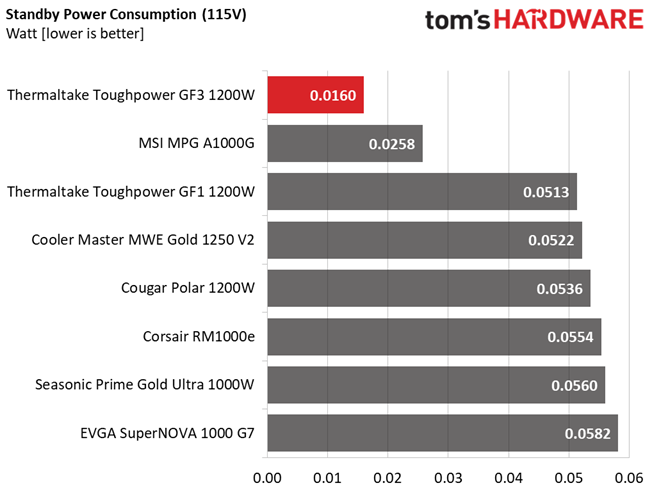
Vampire power is low.
Fan RPM, Delta Temperature and Output Noise
All results are obtained between an ambient temperature of 37 to 47 degrees Celsius (98.6 to 116.6 degrees Fahrenheit).
The fan speed profile is aggressive. A less restrictive fan grille would help lowering fan noise.
The following results were obtained at 30 to 32 degrees Celsius (86 to 89.6 degrees Fahrenheit) ambient temperature.
At normal operating temperatures, close to 30 degrees Celsius, the PSU's passive mode doesn't last long with increased load on the minor rails. Nonetheless, up to 660W noise output remains below 20 dBA. The 30 dBA mark is passed with more than 750W and noise exceeds 40 dBA with more than 890W. Lastly, with 1,090W and higher loads, you will be treated with more than 50 dBA noise.
MORE: Best Power Supplies
MORE: How We Test Power Supplies
MORE: All Power Supply Content
Current page: Load Regulation, Hold-Up Time, Inrush & Leakage Current, Efficiency and Noise
Prev Page Specifications and Part Analysis Next Page Protection Features, DC Power Sequencing, Cross-Load Tests and Infrared Images
Aris Mpitziopoulos is a contributing editor at Tom's Hardware, covering PSUs.
-
hexxum Didn’t the Toughpower gf3 1200w fail ATX 3.0 certification through Cybenetics? Here is a quote with links from Dogzilla09 from Overclockers:Reply
Here check the results (for Thermaltake Toughpower GF3) on the second page, under Results paragraph, there's no row with ATX 3.0 Ready/PCIE 5.0 ready (previous designation) written:
https://www.cybenetics.com/d/cybenetics_TLu.pdfHere's how it should look like on the 1000W GF3 model:
https://www.cybenetics.com/d/cybenetics_1GW.pdfNow here's the MSI Ai1300P (it has different wording, but it's also passed testing).
https://www.cybenetics.com/d/cybenetics_jWP.pdf -
vashtanerada It definitely says that it passed ATX 3.0. Unless something changed since you posted this.Reply -
hexxum I contacted Cybenetics about this and the SilverStone Hela 1200r since both failed. They both failed a transient load test. Thermaltake was already sending them a new test unit, which has since passed and Cybenetics has updated their data sheet. Also contacted SilverStone. They said had sent Cybenetics a preproduction unit and that they’d be in contact with them to get it resolved. I haven’t seen any updates for the Hela 1200r yet.Reply -
Parallax1 I have startup noise problem with this. Im definetly sure its not the fan, i tried to stop it from exterior and still noise happens. I guess high inrush current causing this for 1 second, but is that harmful for psu or pc?Reply
Here is the noise :
https://youtube.com/shorts/An8ypTL-JaU?feature=share -
hexxum ReplyParallax1 said:I have startup noise problem with this. Im definetly sure its not the fan, i tried to stop it from exterior and still noise happens. I guess high inrush current causing this for 1 second, but is that harmful for psu or pc?
Here is the noise :
https://youtube.com/shorts/An8ypTL-JaU?feature=share
I had a Hela 1200r for a hot minute and it made a similar noise. I use a smart plug with my computer to fully cut off power after shut down. In a way it’s like flipping the switch on the psu to fully cut power. I noticed the psu would make this noise when I turned the computer back on. Didn’t seem to happen if I would shutdown the computer and turn it back on without fully cutting the power at the plug, which leads me to believe the noise is from some component in the psu when it first gets loaded with electricity. I ended up returning the Hela 1200r due to it failing atx 3.0 certification. I now have a msi ai1300p and I’ve never heard it make that noise. The Hela 1200r operated fine though so I don’t think this sound is something to worry about.
Also to anyone else following earlier posts of mine in this thread. The Hela 1200r sent a new production unit to Cybenetics and it has now passed atx 3.0 certification. Apparently they had sent a pre production unit first and that’s why it failed one of the transient load tests. -
Parallax1 Reply
Probably both use the same PCB, both are CWT production. I couldn't trust it and then returned it because I was going to use it as a rendering and workstation.hexxum said:I had a Hela 1200r for a hot minute and it made a similar noise. I use a smart plug with my computer to fully cut off power after shut down. In a way it’s like flipping the switch on the psu to fully cut power. I noticed the psu would make this noise when I turned the computer back on. Didn’t seem to happen if I would shutdown the computer and turn it back on without fully cutting the power at the plug, which leads me to believe the noise is from some component in the psu when it first gets loaded with electricity. I ended up returning the Hela 1200r due to it failing atx 3.0 certification. I now have a msi ai1300p and I’ve never heard it make that noise. The Hela 1200r operated fine though so I don’t think this sound is something to worry about.
Also to anyone else following earlier posts of mine in this thread. The Hela 1200r sent a new production unit to Cybenetics and it has now passed atx 3.0 certification. Apparently they had sent a pre production unit first and that’s why it failed one of the transient load tests.
Probably youre right. Mine has cutoff mechanism inside, i can barely hear that something cutting off the power, but you cant control it.
I have ordered FSP Hydro PTM Pro 1200w atx 3.0 now, I know that FSP keeps the product controls tight, I hope I will be satisfied.





